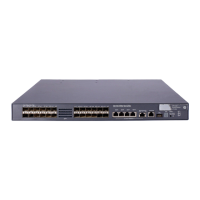14
• Shuts down automatically. The interface shuts down automatically, and stops forwarding any traffic.
To bring up the interface, perform the undo shutdown command or disable the storm constrain
function.
To configure the storm constrain function on an Ethernet interface:
To do… Use the command… Remarks
1. Enter system view
system-view —
2. Set the traffic polling
interval of the storm control
module
storm-constrain interval seconds
Optional.
10 seconds by default.
3. Enter Ethernet interface
view
interface interface-type interface-
number
—
4. Enable storm control, and
set the lower and upper
thresholds for broadcast,
multicast, or unknown
unicast traffic
storm-constrain { broadcast | multicast
| unicast } { pps | kbps | ratio } max-
pps-values min-pps-values
Required.
Disabled by default.
5. Set the control action to
take when monitored traffic
exceeds the upper
threshold
storm-constrain control { block |
shutdown }
Optional.
Disabled by default.
6. Enable the interface to
send storm control
threshold event traps
storm-constrain enable trap
Optional.
By default, the interface sends
traps when monitored traffic
exceeds the upper threshold or
drops below the lower threshold
from the upper threshold.
7. Enable the interface to log
storm control threshold
events
storm-constrain enable log
Optional.
By default, the interface outputs
log messages when monitored
traffic exceeds the upper
threshold or falls below the
lower threshold from the upper
threshold.
For network stability, use the default or set a higher traffic polling interval.
Storm control uses a complete polling cycle to collect traffic data, and analyzes the data in the next cycle.
It takes an interface at least one polling interval and at most two polling interval to take a storm control
action.
Enabling single-port loopback detection on an Ethernet
interface
If an interface receives a packet that it sent out, a loop occurs. Loops may cause broadcast storms,
degrading network performance. For example, you can use loopback detection to detect loops on an
interface and configure the protective action to take on the interface when a loop is detected to shut
down the interface. In addition to the configured protective action, the switch also performs other actions
to alleviate the impact of the loop condition, as described in Table 3.

